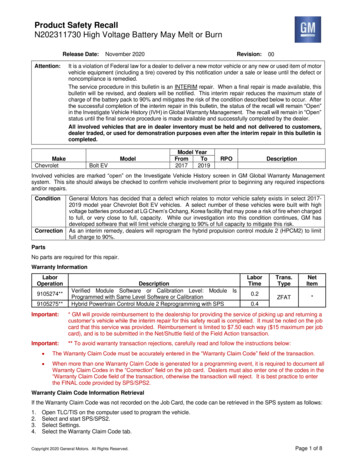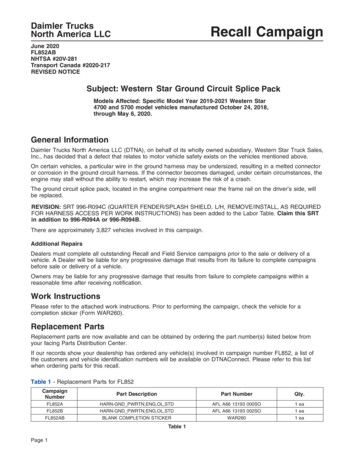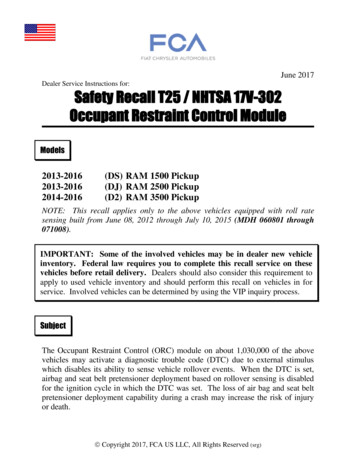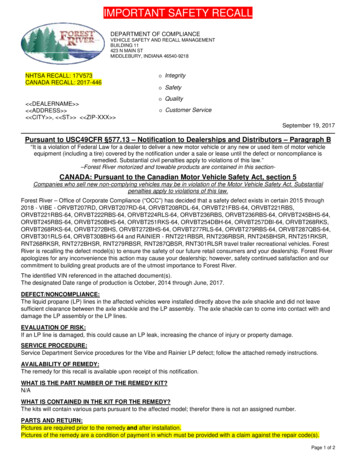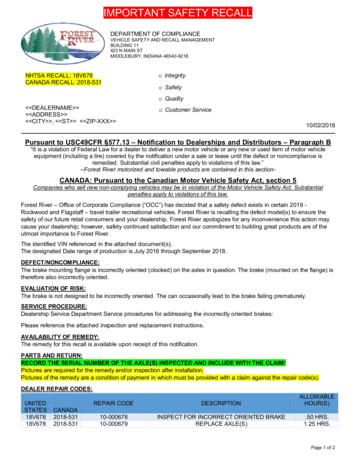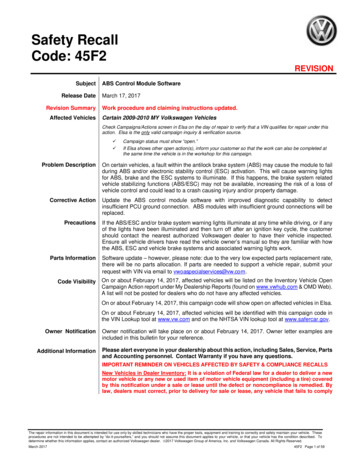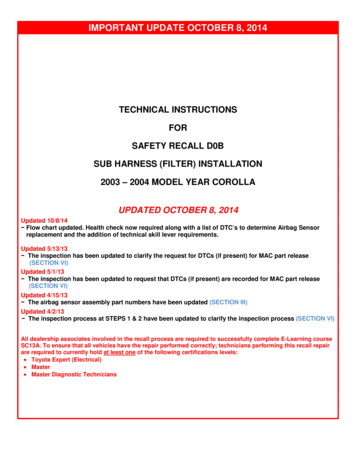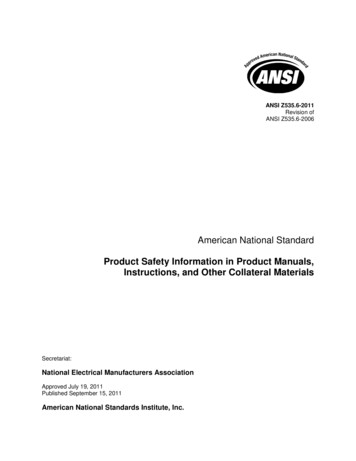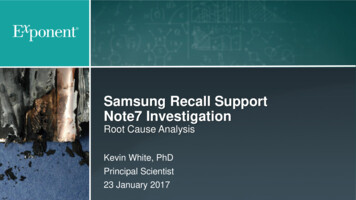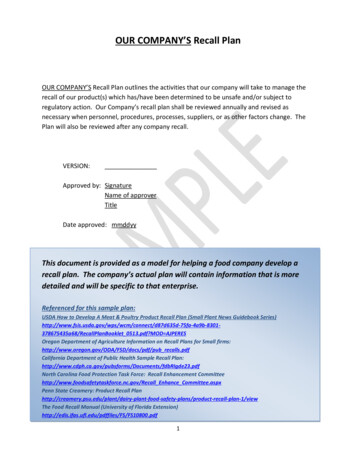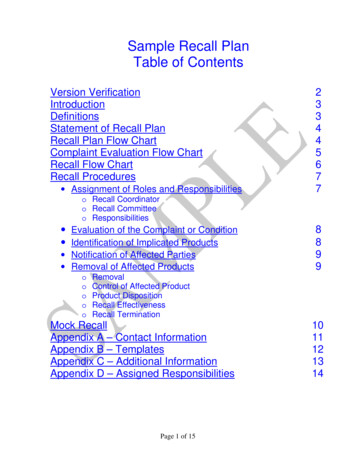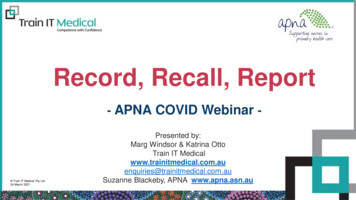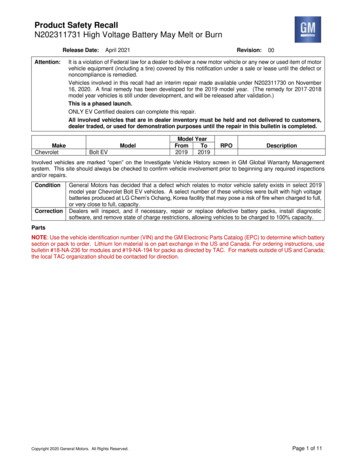
Transcription
Product Safety RecallN202311731 High Voltage Battery May Melt or BurnRelease Date:Attention:MakeChevroletApril 2021Revision:00It is a violation of Federal law for a dealer to deliver a new motor vehicle or any new or used item of motorvehicle equipment (including a tire) covered by this notification under a sale or lease until the defect ornoncompliance is remedied.Vehicles involved in this recall had an interim repair made available under N202311730 on November16, 2020. A final remedy has been developed for the 2019 model year. (The remedy for 2017-2018model year vehicles is still under development, and will be released after validation.)This is a phased launch.ONLY EV Certified dealers can complete this repair.All involved vehicles that are in dealer inventory must be held and not delivered to customers,dealer traded, or used for demonstration purposes until the repair in this bulletin is completed.ModelBolt EVModel YearFromTo20192019RPODescriptionInvolved vehicles are marked “open” on the Investigate Vehicle History screen in GM Global Warranty Managementsystem. This site should always be checked to confirm vehicle involvement prior to beginning any required inspectionsand/or repairs.ConditionCorrectionGeneral Motors has decided that a defect which relates to motor vehicle safety exists in select 2019model year Chevrolet Bolt EV vehicles. A select number of these vehicles were built with high voltagebatteries produced at LG Chem’s Ochang, Korea facility that may pose a risk of fire when charged to full,or very close to full, capacity.Dealers will inspect, and if necessary, repair or replace defective battery packs, install diagnosticsoftware, and remove state of charge restrictions, allowing vehicles to be charged to 100% capacity.PartsNOTE: Use the vehicle identification number (VIN) and the GM Electronic Parts Catalog (EPC) to determine which batterysection or pack to order. Lithium Ion material is on part exchange in the US and Canada. For ordering instructions, usebulletin #18-NA-236 for modules and #19-NA-194 for packs as directed by TAC. For markets outside of US and Canada;the local TAC organization should be contacted for direction.Copyright 2020 General Motors. All Rights Reserved.Page 1 of 11
Product Safety RecallN202311731 High Voltage Battery May Melt or BurnWarranty 105704DescriptionEV Battery Parameter inspection, BCM Programming and HPCM 2ProgrammingADD: Test, Recharge 12 Volt BatteryADD: Test and Replace 12 Volt BatteryCell Battery Module Replacement (Includes EV Battery Parameterinspection, BCM Programming, HPCM 2 Programming and SmokeTest)Row 1Row 2Row 3Row 4Row 5ADD: Test, Recharge 12 Volt BatteryADD: Test and Replace 12 Volt BatteryDrive Motor Battery Replacement and Shipping Preparation(Includes EV Battery Parameter inspection, BCM Programming andHPCM 2 Programming)ADD: Test, Recharge 12 Volt BatteryADD: Test and Replace 12 Volt BatteryWorking Capital Assistance Program Reimbursement – USEDINVENTORY 6.46.26.97.36.6.2.34.3.2.3N/AIMPORTANT: * GM will provide reimbursement to the dealership for providing the service of picking up and returninga customer’s vehicle while the repair for this safety recall is completed. It must be noted on the job card that this servicewas provided. Reimbursement is limited to 7.50 each way ( 15 maximum per job card), and is to be submitted in theNet/Shuttle field of the Field Action transaction.IMPORTANT: Stable 12 Volt vehicle power is required for this inspection/evaluation. If the vehicle required a jump startto get it into the shop or is displaying weak 12 Volt performance, refer to TSB #20-NA-132 for battery testing and warrantyreplacement requirements.NOTE: Most vehicles involved will only require a programming update but there is a slight chance that a high voltagebattery pack repair/replacement will be required. Advise waiting customers prior to starting that the time required willlikely be about an hour but could require longer if parts replacement is required.NOTE: It is recommended dealers assure their EV Battery Depowering Tool (EL-50332) has the most recent softwareupdate. Software updates are available from Special Tools and Software Updates accessed through GlobalConnect.IMPORTANT:** To avoid warranty transaction rejections, carefully read and follow the instructions below: The Warranty Claim Code must be accurately entered in the “Warranty Claim Code” field of the transaction. When more than one Warranty Claim Code is generated for a programming event, it is required to document allWarranty Claim Codes in the “Correction” field on the job card. Dealers must also enter one of the codes in the“Warranty Claim Code field of the transaction, otherwise the transaction will reject. It is best practice to enterthe FINAL code provided by SPS/SPS2.Warranty Claim Code Information RetrievalIf the Warranty Claim Code was not recorded on the Job Card, the code can be retrieved in the SPS system as follows:1.2.3.4.Open TLC/TIS on the computer used to program the vehicle.Select and start SPS/SPS2.Select Settings.Select the Warranty Claim Code tab.The VIN, Warranty Claim Code and Date/Time will be listed on a roster of recent programming events. If the code isretrievable, dealers should resubmit the transaction making sure to include the code in the SPS Warranty Claim Codefield.Working Capital Assistance Program (WCAP) Reimbursement – USED INVENTORY ONLYPage 2 of 11
Product Safety RecallN202311731 High Voltage Battery May Melt or BurnNOTE: USA & Canada Only - To avoid having to “H” route the WCAP transaction for approval, it must be submitted priorto the repair transaction.IMPORTANT: The WCAP ZSET transaction labor code, 9800059, provided in the dealer message sent onNovember 27, 2020, must have been submitted prior to the submittal of the ZFAT transaction labor code or theclaim will reject.***USA & Canada Dealers Only - For vehicles eligible under the Working Capital Assistance Program, the amountshould be submitted in Net Item/Miscellaneous. This amount has been calculated to a daily value for the days that thevehicle was in used dealer inventory and not available for sale. This reimbursement is limited to the number of days fromthe date of the stop sale/stop delivery order November 13, 2020 to the date the inspection or repair closed the recallbulletin. (not to exceed 169 days).Vehicle2019 Chevrolet Bolt EVWorking Capital Assistance Reimbursement AmountUSACanada 8.60 13.92Page 3 of 11
Product Safety RecallN202311731 High Voltage Battery May Melt or BurnService Procedure Do not plug-in charge the vehicle or perform aggressive acceleration and/or braking maneuvers just prior toperforming the GDS2 parameter inspection procedure. Do not clear DTC Information before GDS2 parameter inspection procedure. Do not program any control module until instructed to do so.Procedure 1 GDS2 Parameter Inspection58166311.The vehicle must have a properly charged 12V battery before continuing. If the vehicle has been dormantand/or required a 12V jump start, perform a 12V battery inspection and charge or replace the 12V batterybefore continuing. Refer to Battery Inspection/Test in SI.2.Perform a vehicle diagnostic system check prior to using this diagnostic procedure. Refer to Diagnostic SystemCheck – Vehicle in SI. If any Powertrain DTCs (Pxxxx) are set, store any Freeze Frame/Failure Records and go to DiagnosticTrouble Code (DTC) List – Vehicle in Si. Return to this procedure after DTC repair. If no DTCs are set, go to Step 3.3.Vehicle ON, use GDS2 to view the following data screens while connected to the vehicle: From Module Diagnostics, select Hybrid Powertrain Control Module 2. Data Display Folder Data Display Icon Voltage DataPage 4 of 11
Product Safety RecallN202311731 High Voltage Battery May Melt or Burn Observe and record the parametersHybrid/EV Battery Voltage Sensors Average and Minimum Hybrid/EV Battery Module Voltage.Hybrid/EV Battery Voltage Sensors Average (Value A) :Minimum Hybrid/EV Battery Module Voltage (Value B) :4.Subtract the minimum voltage from the average voltage.Value A – Value B : If the voltage difference is less than or equal to 0.08V, proceed directly to Procedure 3: Software FlashingProcedure. If the voltage difference is greater than 0.08V, Observe and record the value of parameter Hybrid/EVBattery Voltage Sensor with Minimum Voltage and Hybrid/EV Battery Pack State of Charge andproceed to Step 5.Hybrid/EV Battery Voltage Sensor with Minimum Voltage (Value C):Hybrid/EV Battery Pack State of Charge (Value D):5.Observe the battery pack state of charge parameter (Value D), is the SOC 30% or greater? If the battery pack SOC is less than 30%:1.2.3. Plug in Charge the battery pack to between 30 to 50% (do NOT charge the battery pack tofull at this time).Remove the charge cord and allow the battery to rest (vehicle OFF) for 30 minutes.Return to step 1 of Procedure 1: GDS2 Parameter Inspection Procedure.If the battery pack SOC is greater than 30%, proceed to step 6.6.FOR MARKETS WITH CELL MODULE REPLACEMENT CAPABILITIES (Including US, Canada, and SouthKorea): There is at least one battery cell module row that requires replacement. Advise the customer andcoordinate rental vehicle, transportation home, etc. as required. Most vehicles will only require a single cellbattery module section/row. To determine if an additional cell battery module section/row or if the entire batterypack assembly requires replacement proceed to Procedure 2: Multiple Cell Group Identification Procedure.7.FOR MARKETS WITHOUT CELL MODULE REPLACEMENT CAPABILITIES: Advise the customer that anentire replacement battery pack will need to be ordered to service their vehicle. Do not update theHPCM2 with the latest calibration until the pack is replaced. Provide the customer with a courtesy loanervehicle until the repair can be performed. While the vehicle is at the dealership awaiting repair: If the vehicledoes not already contain interim remedy and has failed the inspection, it should not be driven or charged. Theinterim remedy is no longer available to apply to the vehicle.Procedure 2 Multiple Cell Group Identification Procedure1.Vehicle ON, use GDS2 to view the following data screens while connected to the vehicle: From Module Diagnostics, select K16 Battery Energy Control ModuleData Display IconVoltage Data 1, Voltage Data 2, and then Voltage Data 3From Identification Information Folder, select the Identification Information Icon.NOTE: For emailing GDS2 session logs in the US, contact TACsnapshot@GM.Com, In Canada, contactTACsnapshotcanada@GM.Com. All other regions must use their established local technical support center.2.Start a GM TAC case for the vehicle. Email the GDS2 session log from the vehicle to GM TAC. Refer to thelatest version of PIP4902 for assistance in creating and emailing a session log.Page 5 of 11
Product Safety RecallN202311731 High Voltage Battery May Melt or Burn3.4.5.TAC will compare the data from the session log and advise which battery section(s) to replace. In some cases,TAC may advise that the entire pack should be replaced due to multiple cells with low voltage.Replace the identified cell battery module. Refer to Cell Battery Module Replacement (Row 1-5) in SI.After repair proceed to Procedure 3: Software Flashing Procedure.NOTE: While waiting for a replacement battery cell module row to arrive, do not charge the vehicle or drive more than ahalf mile. Follow bulletin #18-NA-236 for module ordering instructions.IMPORTANT: Do not flash any software before repairs are completed. Keep state of charge at or below 90%.Procedure 3 Software Flashing ProcedureThis update will perform the following: Hybrid/EV Powertrain Control Module 2 Revise existing Hybrid/EV Battery Circuit Performance DTCs P0B3C, P0B41, etc. Implement new DTCs P0BBD. Implement new GDS2 parameters to support DTCs P0BBD. Restore maximum battery pack charging to 100% capability. Body Control Module Coordinated change to implement thermal propagation warning feature.Caution: Before downloading the update files, be sure the computer is connected to the internet through a networkcable (hardwired). DO NOT DOWNLOAD or install the files wirelessly. If there is an interruption during programming,programming failure or control module damage may occur.Note: Carefully read and follow the instructions below. Ensure the programming tool is equipped with the latest software and is securely connected to the data linkconnector. If there is an interruption during programming, programming failure or control module damage mayoccur. Stable battery voltage is critical during programming. Any fluctuation, spiking, over voltage or loss of voltagewill interrupt programming. Install a GM Authorized Programming Support Tool to maintain system voltage.Refer to www.gmdesolutions.com for further information. If not available, connect a fully charged 12 V jumperor booster pack disconnected from the AC voltage supply. DO NOT connect a battery charger. Turn OFF or disable systems that may put a load on the vehicle battery such as: interior lights, exterior lights(including daytime running lights) HVAC etc. Clear DTCs after programming is complete. Clearing powertrain DTCs will set the Inspection/Maintenance (I/M)system status indicators to NO.Page 6 of 11
Product Safety RecallN202311731 High Voltage Battery May Melt or Burn56444775431207Important: Techline Connect and TIS2WEB screens shown above.Important: If the same calibration/software warning is noted on the TLC or SPS Summary screen, select OKand follow screen instructions. After a successful programming event, the WCC is located in the ServiceProgramming System dialogue box of the SPS Summary screen. No further action is required. Refer to theWarranty section of the bulletin.1.Reprogram the K114B Hybrid/EV Powertrain Control Module 2. Refer to K114B Hybrid/EV PowertrainControl Module 2: Programming and Setup in SI.Page 7 of 11
Product Safety RecallN202311731 High Voltage Battery May Melt or Burn2.Reprogram the K9 Body Control Module. Refer to K9 Body Control Module Programming and Setup in SI.56444785431209Note:The screenshots above are an example of module programming and may not be indicative of thespecific module that is being programmed. Module selection and VIN information have been blackedout.Important: To avoid warranty transaction rejections, you MUST record the warranty claim code provided onthe Warranty Claim Code (WCC) screen shown above on the job card. Refer to callout 1 above for the locationof the WCC on the screen.3. Record SPS Warranty Claim Code on job card for warranty transaction submission.Prior to returning the vehicle to the customer:1.Vehicle ON, perform the Diagnostic System Check – Vehicle.Page 8 of 11
Product Safety RecallN202311731 High Voltage Battery May Melt or Burn 2.If any DTCs are set, store any Freeze Frame/Failure Records and go to Diagnostic Trouble Code (DTC)List – Vehicle in Si. Return to this procedure after DTC repair. If no DTCs are set, go to Step 2.Vehicle ON, use GDS2 to view Specific DTC status: From Module Diagnostics, select Hybrid Powertrain Control Module 2. Select Diagnostic Trouble Codes folder Select Specific DTC Ensure the following DTCs have Ran and Passed this ignition: DTC P0BBD. If the DTCs have ran and passed procced to Step 3 If the DTCs have failed go to Diagnostic Trouble Code (DTC) List – Vehicle If DTC P0BBD is not supported an error has occurred during programming, repeat Procedure 3: SoftwareFlashing Procedure.58166373.If the customer is not waiting, plug-in charge the vehicle and ensure battery pack state of charge is 80% orgreater. 80% state of charge is represented when 3 bars remain unlit on the vehicle instrument panel gaugedisplay. You may use Level 1, Level 2 or DC fast charging (note: After programming, the vehicle must be drivenat vehicle speeds greater than 3 km/h (2 mph) to enable DC fast charging).Dealer Responsibility – For USA & Export (USA States, Territories, and Possessions)It is a violation of Federal law for a dealer to deliver a new motor vehicle or any new or used item of motor vehicleequipment (including a tire) covered by this notification under a sale or lease until the defect or noncompliance isremedied.The US National Traffic and Motor Vehicle Safety Act provides that each vehicle that is subject to a recall of this typemust be adequately repaired within a reasonable time after the customer has tendered it for repair. A failure to repairwithin sixty days after tender of a vehicle is prima facie evidence of failure to repair within a reasonable time. If thecondition is not adequately repaired within a reasonable time, the customer may be entitled to an identical or reasonablyequivalent vehicle at no charge or to a refund of the purchase price less a reasonable allowance for depreciation. Toavoid having to provide these burdensome remedies, every effort must be made to promptly schedule an appointmentwith each customer and to repair their vehicle as soon as possible. In the recall notification letters, customers are toldhow to contact the US National Highway Traffic Safety Administration if the recall is not completed within a reasonabletime.Dealer Responsibility – AllAll new, used, GM Certified Used, courtesy transportation vehicles, dealer shuttle vehicles, etc. in dealers' possessionand subject to this recall must be held and inspected/repaired per the service procedure of this bulletin before customerstake possession of these vehicles. Involved vehicles must be held and not delivered to customers, dealer-traded,released to auction, used for demonstration, or any other purpose.All GM Certified Used vehicles currently in the dealers’ inventory within the Certified Pre-Owned Inventory System(CPOIS) will be de-certified and must be held and remedied per the service procedure in this bulletin. Upon submittingPage 9 of 11
Product Safety RecallN202311731 High Voltage Battery May Melt or Burnan accepted/paid warranty transaction in the Global Warranty Management (GWM) system, the vehicle can be re-certifiedfor sale within the CPOIS system, or once again be used in the CTP program.Dealers are to service all vehicles subject to this recall at no charge to customers, regardless of mileage, age of vehicle,or ownership, from this time forward.Customers who have recently purchased vehicles sold from your vehicle inventory, and for which there is no customerinformation indicated on the dealer listing, are to be contacted by the dealer. Arrangements are to be made to make therequired correction according to the instructions contained in this bulletin. A copy of the customer letter is provided in thisbulletin for your use in contacting customers. Recall follow-up cards should not be used for this purpose, since thecustomer may not as yet have received the notification letter.In summary, whenever a vehicle subject to this field action enters your vehicle inventory you must take the stepsnecessary to ensure the program correction has been made before selling the vehicle. In addition, for vehicles enteringyour facility for service, you are required to ensure the customer is aware of the open field action and make everyreasonable effort to implement the program correction as set forth in this bulletin prior to releasing the vehicle.Dealer ReportsFor dealers with involved vehicles, a listing has been prepared and will be available through GM GlobalConnect MaxisField Action Reports or sent directly to export dealers. The Inventory tab of the dealer reports will contain VINs that applyto this recall. This information is intended to assist dealers with the PROMPT COMPLETION of these vehicles. TheCustomer In-Service tab will contain customer names and addresses from Motor Vehicle Registration Records. The useof such motor vehicle registration
Product Safety Recall N202311731 High Voltage Battery May Melt or Burn Page 3 of 11 NOTE: USA & Canada Only - To avoid having to “H” route the WCAP transaction for approval, it must be submitted prior to the repair transaction. IMPORTANT: The WCAP ZSET transaction labor code, 9800059, provided in the dealer message sent on November 27,
